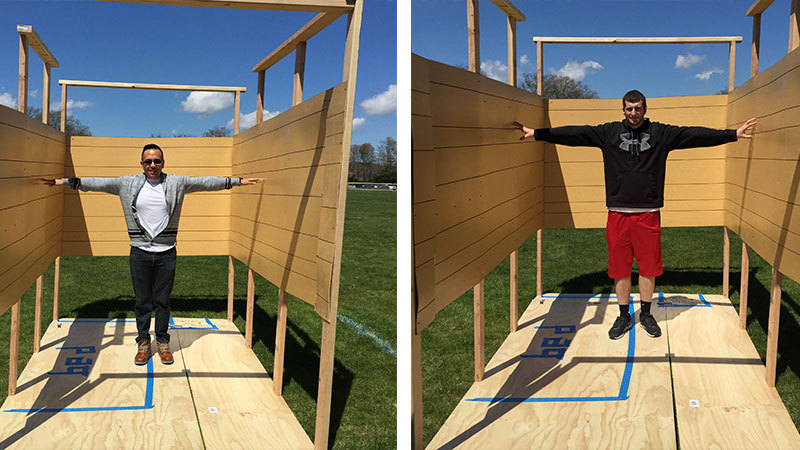Imagine rolling out of bed and being greeted with a wall a mere three feet from your mattress. Surrounded on all sides by cement. Alone, locked in a windowless cell the size of an elevator.
Students at SJC Long Island on April 26 were offered a glimpse and feel of just how claustrophobic modern-day solitary confinement can be — by way of a makeshift wooden cell exhibit placed in the middle of the campus’ athletic field.
“This is just crazy,” said student Annemarie Taggart. “It’s one thing to be told how big it is, but to see it is a whole different thing. I step off the bed and my shoulders are touching the walls. How can anyone live in this? It’s insane.”
The exhibit was part of the Criminal Justice Club’s event to promote the Campaign Against Institutional Confinement (CAIC). Victor Pate, chairman of the National Action Network, visited campus to deliver a lecture rallying against solitary confinement, and to promote the assistance of formerly incarcerated inmates as they adjust to reentering society.

Victor Pate with students and faculty from SJC Long Island.
Pate was released from prison in 1995, having spent nearly two years in solitary confinement for various offenses, including having too many bed sheets in his prison cell.
“It’s as if the whole world has disappeared and this space that I occupy is the only space that exists for me,” Pate told The Guardian in a piece published on April 27, 2016. “All I am left in is a small, dark, deep space and the space never changes and all I find is darkness around me and I just can’t seem to get out of this darkness. You do begin to hallucinate after a while and I did hear some voices inside my head.”
According to the CAIC, some 4,500 men, women and children are currently inside solitary confinement, or other forms of extreme isolation in New York State prisons.
“It is torture,” said student Christian Vizcarra, “and it changes the perspective from hearing about it to actually see how small and unbearable it is in-person. It is extremely depressing. Knowing that a human being is be held in there.”
Solitary Confinement and Its Effect on Prisoners (courtesy of the CAIC)
- People in isolated confinement in New York State spend 22 to 24 hours a day locked in a cell the size of an elevator, alone or with one other person. They do not receive any meaningful programs or therapy, and cannot make phone calls.
- The sensory deprivation, lack of normal human interaction and extreme idleness can lead to intense suffering and severe psychological damage.
- Isolated confinement fails to address the underlying causes of problematic behavior.
- Isolated confinement serves no legitimate purpose; states that reduced their use of isolation in prisons by up to 75 percent saw significant decreases in prison violence.
Learn about the HALT Act and what you can do to end solitary confinement.

SJC Long Island students experienced solitary confinement by stepping into a mock cell on campus this week @NYCAIC pic.twitter.com/7toJTA56Vo
— St. Joseph’s College (@SJCNY) April 28, 2016
